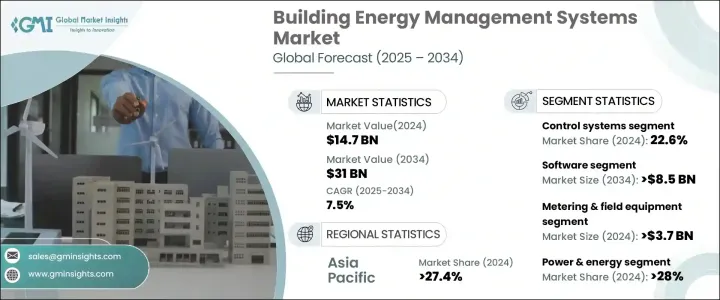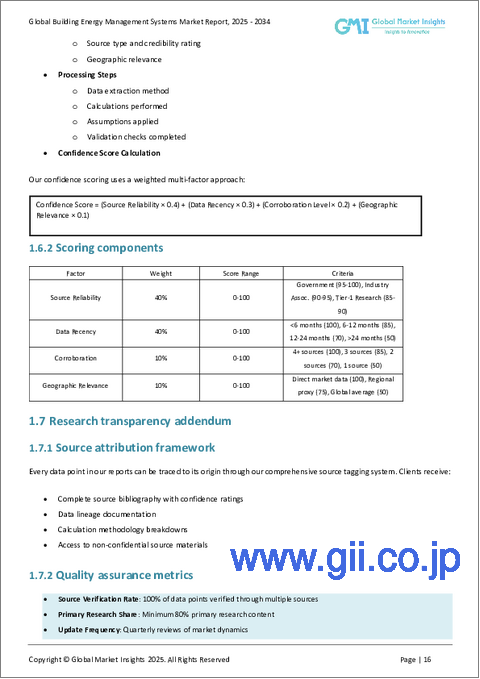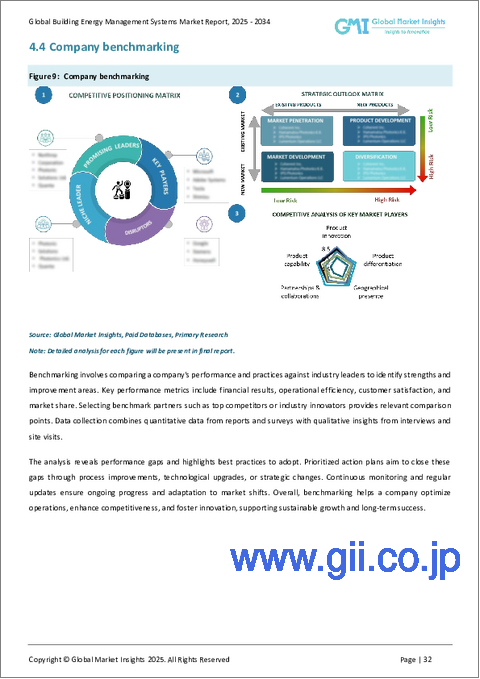|
|
市場調査レポート
商品コード
1699291
ビルエネルギーマネジメントシステム(BEMS)市場の機会、成長促進要因、産業動向分析、2025年~2034年の予測Building Energy Management Systems Market Opportunity, Growth Drivers, Industry Trend Analysis, and Forecast 2025-2034 |
||||||
カスタマイズ可能
|
|||||||
| ビルエネルギーマネジメントシステム(BEMS)市場の機会、成長促進要因、産業動向分析、2025年~2034年の予測 |
|
出版日: 2025年02月19日
発行: Global Market Insights Inc.
ページ情報: 英文 100 Pages
納期: 2~3営業日
|
全表示
- 概要
- 目次
世界のビルエネルギーマネジメントシステム(BEMS)市場は、2024年に147億米ドルに達し、2025年から2034年にかけてCAGR 7.5%で拡大すると予測されています。
厳しい規制の枠組みや持続可能性への関心の高まりを背景に、スマートエネルギーソリューションの採用が増加していることが、この拡大に拍車をかけています。世界各国の政府は、商業ビルや産業ビルにエネルギー効率の高い技術の導入を義務付ける政策を実施しており、これが高度なエネルギーマネジメントソリューションの需要を押し上げています。エネルギー消費量の増加と運用コストの最小化の必要性が、企業が最先端のBEMS技術に投資するインセンティブをさらに高めています。

AI主導の分析、IoT対応の自動化、クラウドベースのエネルギー最適化プラットフォームの統合により、市場は急速な技術進歩を目の当たりにしています。企業は、エネルギー利用の改善、建物性能の向上、積極的な持続可能性目標の達成のために、こうした技術革新を活用しています。再生可能エネルギーへの依存の高まりとカーボンフットプリント削減の重視が相まって、BEMSの採用がさらに加速しています。さらに、エネルギーコストの高騰と送電網の信頼性に対する懸念の高まりにより、企業は電力使用を最適化するために堅牢なエネルギー監視システムを導入するようになっています。持続可能なインフラとスマートビルディングに対する民間部門の投資は、企業が長期的なエネルギー効率を確保しながら規制遵守を達成しようとしているため、市場の成長を促進しています。
| 市場範囲 | |
|---|---|
| 開始年 | 2024 |
| 予測年 | 2025-2034 |
| 開始金額 | 147億米ドル |
| 予測金額 | 310億米ドル |
| CAGR | 7.5% |
ソフトウェア部門は、2034年までに85億米ドルを生み出すと予測されており、大幅な拡大が見込まれています。企業は、業務を合理化しエネルギーの浪費を削減するために、インテリジェントなエネルギー監視と自動化を優先しています。リアルタイムのデータ分析とAIを活用した自動化を備えた先進的なソフトウェア・ソリューションは、組織がエネルギー・ニーズを管理する方法に革命をもたらしています。エネルギー配分と消費パターンを最適化することで、企業はコストを削減し、全体的な効率を向上させることができます。産業がデジタルトランスフォーメーションにシフトする中、スマートエネルギーマネジメントソフトウェアの需要は増加の一途をたどっており、今後10年間の市場成長の重要な原動力と位置付けられています。
電力・エネルギー部門は、2024年の市場シェア全体の28%を占めており、その影響力は今後数年で大きく拡大すると予想されます。急速な工業化と都市化により、世界のエネルギー需要はかつてないほど急増し、高度なエネルギーマネジメントソリューションの必要性が高まっています。発電・配電部門の各組織は、資源利用を最適化し二酸化炭素排出量を削減するため、エネルギー効率の高い技術への戦略的投資を行っています。太陽光発電や風力発電などの再生可能エネルギー源の統合が進んでいることも、BEMSソリューションの採用拡大に貢献しています。企業が持続可能な開発と省エネルギーに注力する中、この分野は世界のBEMSプロバイダーにとって引き続き重要な成長分野です。
米国のビルエネルギーマネジメントシステム(BEMS)市場は、2024年に29億米ドルと評価され、顕著な導入の急増を経験しています。建物インフラの近代化とエネルギー最適化の重視の高まりが相まって、商業および住宅部門全体の需要を牽引しています。2034年までに、北米市場はスマートビルディング技術への投資の増加により、75億米ドルを生み出すと予想されています。政府の支援政策やエネルギー効率義務化などの規制措置は、高度なエネルギーマネジメントシステムの統合を促す明確な基準を設けることで業界を形成しています。企業が業務効率の向上と持続可能性目標の達成を目指す中、インテリジェント・ビル技術へのシフトが今後10年間の市場拡大を促進するとみられます。
目次
第1章 調査手法と調査範囲
- 市場の定義
- 基本推定と計算
- 予測計算
- データソース
第2章 エグゼクティブサマリー
第3章 業界洞察
- エコシステム分析
- 規制状況
- 業界への影響要因
- 促進要因
- 業界の潜在的リスク&課題
- 成長ポテンシャル分析
- ポーター分析
- PESTEL分析
第4章 競合情勢
- 戦略ダッシュボード
- イノベーションと持続可能性の展望
第5章 市場規模・予測:コンポーネント別、2021年~2034年
- 主要動向
- メータリング&フィールド機器
- ハードウェア
- ソフトウェア
- ネットワーク機器
- 制御システム
- センサー
- その他
第6章 市場規模・予測:用途別、2021年~2034年
- 主要動向
- 電力・エネルギー
- IT関連
- 製造業
- エンタープライズ
- ヘルスケア
- その他
第7章 市場規模・予測:地域別、2021年~2034年
- 主要動向
- 北米
- 米国
- カナダ
- メキシコ
- 欧州
- 英国
- フランス
- ドイツ
- イタリア
- ロシア
- スペイン
- アジア太平洋
- 中国
- オーストラリア
- インド
- 日本
- 韓国
- 中東・アフリカ
- サウジアラビア
- アラブ首長国連邦
- トルコ
- 南アフリカ
- エジプト
- ラテンアメリカ
- ブラジル
- アルゼンチン
第8章 企業プロファイル
- ABB
- C3.ai
- Dexma Sensors
- Eaton
- Emerson Electric
- ENGIE Impact
- eSight Energy
- General Electric
- GridPoint
- Honeywell
- IBM
- Ingersoll Rand
- Johnson Controls
- Mitsubishi Heavy Industries
- NX Technologies
- Optimum Energy
- Rockwell Automation
- Schneider Electric
- Siemens
- SkyFoundry
- Telkonet
- Toshiba
The Global Building Energy Management System Market reached USD 14.7 billion in 2024 and is projected to expand at a CAGR of 7.5% between 2025 and 2034. The increasing adoption of smart energy solutions, driven by stringent regulatory frameworks and a growing focus on sustainability, is fueling this expansion. Governments worldwide are implementing policies that require commercial and industrial buildings to deploy energy-efficient technologies, pushing demand for advanced energy management solutions. Rising energy consumption and the need to minimize operational costs have further incentivized businesses to invest in cutting-edge BEMS technologies.

With the integration of AI-driven analytics, IoT-enabled automation, and cloud-based energy optimization platforms, the market is witnessing rapid technological advancements. Companies are leveraging these innovations to improve energy utilization, enhance building performance, and meet aggressive sustainability goals. The increasing reliance on renewable energy sources, coupled with the growing emphasis on carbon footprint reduction, is further accelerating BEMS adoption. Additionally, the escalating energy costs and rising concerns over grid reliability are prompting businesses to implement robust energy monitoring systems to optimize electricity usage. Private sector investments in sustainable infrastructure and smart buildings are driving market growth as enterprises seek to achieve regulatory compliance while ensuring long-term energy efficiency.
| Market Scope | |
|---|---|
| Start Year | 2024 |
| Forecast Year | 2025-2034 |
| Start Value | $14.7 Billion |
| Forecast Value | $31 Billion |
| CAGR | 7.5% |
The software segment is poised for substantial expansion, with projections indicating it will generate USD 8.5 billion by 2034. Businesses are prioritizing intelligent energy monitoring and automation to streamline operations and reduce energy wastage. Advanced software solutions equipped with real-time data analytics and AI-powered automation are revolutionizing the way organizations manage their energy needs. By optimizing energy distribution and consumption patterns, these solutions enable companies to lower costs and improve overall efficiency. With industries shifting towards digital transformation, the demand for smart energy management software continues to rise, positioning it as a key driver of market growth in the coming decade.
The power and energy sector accounted for 28% of the total market share in 2024, and its influence is expected to expand significantly in the coming years. Rapid industrialization and urbanization have led to an unprecedented surge in global energy demand, increasing the need for sophisticated energy management solutions. Organizations across the power generation and distribution sectors are making strategic investments in energy-efficient technologies to optimize resource utilization and reduce carbon emissions. The growing integration of renewable energy sources, such as solar and wind power, is further contributing to the rising adoption of BEMS solutions. As companies focus on sustainable development and energy conservation, the sector remains a crucial growth area for BEMS providers worldwide.
The US building energy management system market was valued at USD 2.9 billion in 2024 and is experiencing a notable surge in adoption. The modernization of building infrastructure, coupled with the growing emphasis on energy optimization, is driving demand across commercial and residential sectors. By 2034, the North American market is expected to generate USD 7.5 billion, fueled by increasing investments in smart building technologies. Regulatory measures, including government-backed policies and energy efficiency mandates, are shaping the industry by establishing clear standards that encourage the integration of advanced energy management systems. As companies seek to enhance operational efficiency and meet sustainability targets, the shift towards intelligent building technologies is set to propel market expansion over the next decade.
Table of Contents
Chapter 1 Methodology & Scope
- 1.1 Market definitions
- 1.2 Base estimates & calculations
- 1.3 Forecast calculation
- 1.4 Data sources
- 1.4.1 Primary
- 1.4.2 Secondary
- 1.4.2.1 Paid
- 1.4.2.2 Public
Chapter 2 Executive Summary
- 2.1 Industry synopsis, 2021 - 2034
Chapter 3 Industry Insights
- 3.1 Industry ecosystem analysis
- 3.2 Regulatory landscape
- 3.3 Industry impact forces
- 3.3.1 Growth drivers
- 3.3.2 Industry pitfalls & challenges
- 3.4 Growth potential analysis
- 3.5 Porter's analysis
- 3.5.1 Bargaining power of suppliers
- 3.5.2 Bargaining power of buyers
- 3.5.3 Threat of new entrants
- 3.5.4 Threat of substitutes
- 3.6 PESTEL analysis
Chapter 4 Competitive landscape, 2024
- 4.1 Strategic dashboard
- 4.2 Innovation & sustainability landscape
Chapter 5 Market Size and Forecast, By Component, 2021 – 2034 (USD Million)
- 5.1 Key trends
- 5.2 Metering & field equipment
- 5.3 Hardware
- 5.4 Software
- 5.5 Networking device
- 5.6 Control systems
- 5.7 Sensors
- 5.8 Others
Chapter 6 Market Size and Forecast, By Application, 2021 – 2034 (USD Million)
- 6.1 Key trends
- 6.2 Power & energy
- 6.3 IT
- 6.4 Manufacturing
- 6.5 Enterprise
- 6.6 Healthcare
- 6.7 Others
Chapter 7 Market Size and Forecast, By Region, 2021 – 2034 (USD Million)
- 7.1 Key trends
- 7.2 North America
- 7.2.1 U.S.
- 7.2.2 Canada
- 7.2.3 Mexico
- 7.3 Europe
- 7.3.1 UK
- 7.3.2 France
- 7.3.3 Germany
- 7.3.4 Italy
- 7.3.5 Russia
- 7.3.6 Spain
- 7.4 Asia Pacific
- 7.4.1 China
- 7.4.2 Australia
- 7.4.3 India
- 7.4.4 Japan
- 7.4.5 South Korea
- 7.5 Middle East & Africa
- 7.5.1 Saudi Arabia
- 7.5.2 UAE
- 7.5.3 Turkey
- 7.5.4 South Africa
- 7.5.5 Egypt
- 7.6 Latin America
- 7.6.1 Brazil
- 7.6.2 Argentina
Chapter 8 Company Profiles
- 8.1 ABB
- 8.2 C3.ai
- 8.3 Dexma Sensors
- 8.4 Eaton
- 8.5 Emerson Electric
- 8.6 ENGIE Impact
- 8.7 eSight Energy
- 8.8 General Electric
- 8.9 GridPoint
- 8.10 Honeywell
- 8.11 IBM
- 8.12 Ingersoll Rand
- 8.13 Johnson Controls
- 8.14 Mitsubishi Heavy Industries
- 8.15 NX Technologies
- 8.16 Optimum Energy
- 8.17 Rockwell Automation
- 8.18 Schneider Electric
- 8.19 Siemens
- 8.20 SkyFoundry
- 8.21 Telkonet
- 8.22 Toshiba





